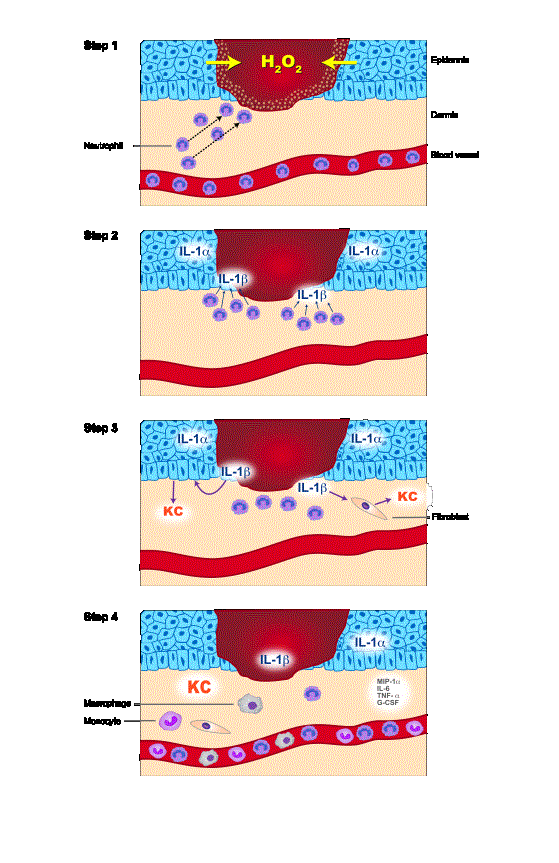 February 28, 2011
February 28, 2011
Healing Postsurgery Wounds
By Carolyn Gutierrez
For The Record
Vol. 23 No. 4 P. 24
While researchers investigate new methods for improving the recovery process, healthcare professionals employ time-tested strategies to prevent infections and speed healing.
How the human body recovers from a surgical wound depends on the complicated and delicate interplay between biology and hygiene. Thanks to developing technologies in molecular science, researchers have been able to take a more complete look at the physiology of healing, while nurses working in the trenches at state-of-the-art hospitals and medical centers promote patient education and hands-on healing to alleviate the mental and physical stresses of surgery.
Wound Biology Study
In a two-part study published in the December issue of Anesthesia & Analgesia, researchers at Stanford University analyzed the complex molecular factors affecting the healing process of surgical incisions.
The basic biological response to a wound consists of three stages. In the first stage, directly after incision, clotting brings about hemostasis (eg, the stopping of blood flow). Neutrophils, the most common inflammatory white blood cells, and macrophages, very large white blood cells, immediately begin to congregate into the wounded area. This is known as the inflammatory phase.
Two to 10 days after the incision is made, the second stage of wound healing—the proliferative phase—begins. During this time, new tissue is formed. The third and final stage of wound repair (the remodeling phase), which can last anywhere from weeks to months, consists of tissue remodeling. During this stage, apoptosis, or cell death, occurs, leading to fibrosis and scar tissue.
In the first part of the study, scientists examined the incisional wound responses in 16 strains of inbred mice. Following a protocol approved by the Stanford University Institutional Animal Care and Use Committee, scientists collected hindpaw incision-wound skin tissues from 8-week-old male mice. The researchers examined the responses of cytokines and chemokines—protein molecules that act as mediators in a mammal’s immune system. Chemokines are small cytokines that “attract” white blood cells to promote healing. When a wound is present, the signaling molecule interleukin 1 (IL-1) triggers the release of other cytokines and chemokines that then regulate inflammation.
“We measured about 20 different cytokines and other proteins that were produced in the wounds across the strains,” notes Gary Peltz, MD, PhD, one of the researchers involved in the project. The scientists genetically mapped the variations in levels of IL-1 onto a pathway that regulated IL-1 production. “IL-1 is a cytokine that has had a known role in pain and inflammation,” says Peltz. “However, it wasn’t known that it itself regulated the production of chemokines.”
The Stanford researchers found that in mice, if IL-1’s receptor was blocked, inflammatory mediators were markedly decreased, which in turn decreased the pain response. In the second study, Peltz says, “we went and looked at two different human wounds: women undergoing cesarean section and people experiencing a UV-induced sunburn. In both of these cases, there was a strong correlation between IL-1 and the production of these inflammatory chemokines in humans. So by doing this type of analysis, we could show that IL-1 plays a major role [in wound healing], opening up the possibility of inhibiting IL-1 for a brief period in a perioperative setting to actually get better outcomes in wound healing and wound pain.”
Stanford researchers will continue to analyze the potential of IL-1 inhibitors over the next year. “What we’re proposing,” Peltz says, “is to really change the way we approach pain relief and wound healing. Instead of using narcotics and nonsteroidals and other things that can kind of deaden pain or have a limited effect, we’re going to try and see if we can open up a new era where we can improve healing and decrease pain by selectively removing certain mediators and see if that works.”
Until that time, when it comes to wound care on a nonmolecular level, it will be up to healthcare professionals to monitor patients’ conditions. “The nurse’s role is really key in preventing infection,” says Mary McDermott, RN, assistant vice president of nursing at the Hospital for Special Surgery (HSS) in New York City. At hospitals such as HSS, a specialty orthopedic hospital where more than 20,000 orthopedic surgeries are performed annually, nurses and clinicians diligently observe protocols to restore the health and well-being of surgery patients.
Infection Prevention
To prevent infection following surgery, the first dose of prophylactic antibiotic is administered within an hour of the surgical incision, followed by two additional doses over a 24-hour period. In addition, a patient’s skin is meticulously prepared. “One of the things that we do not do is shave the skin,” says McDermott. “Those of us who have been in nursing a long time would previously prep and shave a patient’s skin, but it was found that the shaving created some micronicks in the skin, predisposing the patient to infection. So now what we do is clip the hair off the skin.”
Before surgery, many hospitals require some patients to take a shower with an antibiotic soap known as betadine. Depending on a surgeon’s preference, nurses wash the surgical site with betadine or chlorhexadine, another antibiotic soap.
In hospitals, the most intuitive practice for preventing infection is the deceptively simple act of hand washing. “Nurses really promote and educate about the importance of hand hygiene in the prevention of infection,” says McDermott. “And we do observational audits to make sure that staff are compliant. We watch staff take care of patients and then observe that they follow the hand hygiene guidelines to make sure that prior to working with a patient and when leaving a patient’s room or finishing direct patient care, they wash their hands.”
McDermott credits much of HSS’ low infection rate to meticulous hand-washing protocols. Waterless soaps and hand-washing sinks that are widespread throughout the hospital help get the message across.
Symptoms
Signs of infection at a patient’s surgical site include increased, unexplained pain; redness, including red streaks radiating from the wound; foul-smelling green, white, or yellow pus or fluid discharging from the incision; swelling or puffiness around the wound; the incision feeling “hot” to the touch; and high fever and general malaise. Some infections can become so severe that they lead to a condition known as wound dehiscence in which the incision “splits open.”
Diligent cleaning and dressing of the wound site, along with compliance to postoperative instructions, can help patients avoid complications. Also, being in general good health helps promote healing. For example, studies within the last 10 years indicate that smoking produces a higher rate of infection and dehiscence in postoperative incisional wounds. Of note is a 2010 study conducted at the Copenhagen Wound Healing Center that suggests smokers experience a delayed healing process and that smoking cessation reduces infection.
Pain Control in Wound Care
For controlling pain, patients are prescribed nonsteroidal anti-inflammatory drugs such as Mobic, which help reduce inflammation of surgical wounds, or oral long-acting pain medications prior to surgery. Once in the operating room, depending on the surgical procedure, a regional anesthesia may be administered, which, unlike general anesthesia, can block an entire extremity, allowing a patient to remain awake. For example, someone undergoing a total knee replacement may receive a femoral nerve block that involves putting an anesthetic directly into the femoral nerve to effectively block pain during the operation.
Regional anesthesia is also used in epidural catheters in which an anesthesiologist places an epidural catheter into the epidural space to administer analgesic and anesthetic medications, reducing pain and blocking sensation.
“We have a very proactive acute pain service,” says McDermott. “Patient-controlled analgesia machines allow the patients after surgery to have some control over the delivery of their pain medication through either the epidural catheter that was placed intra-op or through an intravenous route. As we program the pump to deliver medication automatically every hour, the patients can dose themselves. We use this type of medication for the first 24 or 48 hours after surgery, and throughout that time there are controls on the machines so that the patient does not get too much medication. In addition to the machine, we start the patient on some oral medications.”
Every four hours, nurses monitor the visual analogue scale, which measures pain severity. Depending on the results of the questionnaire, the amount of medication is adjusted accordingly.
Promoting Healing
A patient’s diet plays a crucial role in wound healing following surgery. A lack of protein can undermine the immune response within cells and dramatically slow down the healing process.
“Nurses do a nutritional screening when the patient comes in for surgery; we do what we call an initial patient assessment,” McDermott says. “We ask the patients questions such as do they follow a special diet, have they lost weight recently, etc and make sure they have good nutrition when they come in. Then we have a nutritionist come in and talk with the patient [and he or she does] a screening as well. Oftentimes they’ll prescribe high-protein diets to patients who are at risk or supplements to promote the patient’s intake.”
Nausea may prevent patients from obtaining much-needed sustenance following surgery. “Sometimes we’ll administer medication like scopolamine patches; some clinicians use them to reduce nausea in patients,” says McDermott. “During surgery we may give a patient antinausea medication intravenously.”
To promote wound healing, simple things matter a great deal. “We try to make food look appealing; we try to make the environment look appealing,” says McDermott. “We make sure that cold food is served cold and hot food is served hot.”
Nurses encourage patients to listen to music on their iPods; breathing and relaxation exercises can also help with pain and expedite healing. Nurses and clinicians also encourage early mobilization that not only fosters healing but also promotes a feeling of normalcy.
— Carolyn Gutierrez is a freelance writer based in New York City.
A Model Approach
According to Stanford researchers, there is a four-step model of cellular recruitment and activation within incisional wounds as represented in the accompanying figures.
Immediately after an incision, neutrophil entry into the wound is initiated by a gradient of hydrogen peroxide (or other mediators) produced by the wounded tissue (step 1). The wound-infiltrating phagocytes produce interleukin (IL)-1 beta, and keratinocytes produce IL-1 along with other mediators, which promotes leukocyte recruitment into the wound (step 2). In response to the IL-1 produced, keratinocytes and fibroblasts within the wound are stimulated to produce keratinocyte-derived chemokine and other mediators (step 3). The inflammatory mediators produced by the infiltrating phagocytes and resident cells promote continued cycles of recruitment and activation of other leukocytes within the wound (step 4).
— CG




